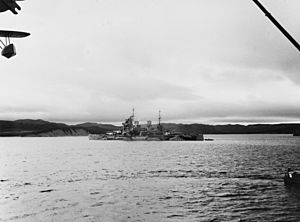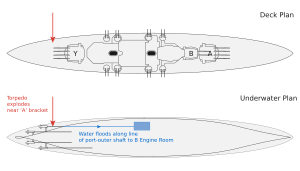HMS Prince of Wales (53) facts for kids
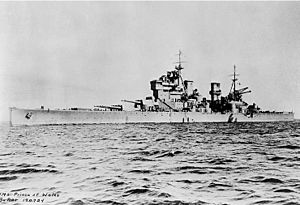 |
|
Quick facts for kids History |
|
|---|---|
| Name | Prince of Wales |
| Ordered | 29 July 1936 |
| Builder | Cammell Laird and Company, Ltd., Birkenhead |
| Laid down | 1 January 1937 |
| Launched | 3 May 1939 |
| Completed | 31 March 1941 |
| Commissioned | 19 January 1941 |
| Identification | Pennant number: 53 |
| Motto | "Ich Dien" – German: "I serve" |
| Nickname(s) | PoW |
| Fate | Sunk on 10 December 1941 by Japanese air attack off Kuantan, South China Sea |
| General characteristics | |
| Class and type | King George V-class battleship |
| Displacement | 43,786 tons (deep) |
| Length |
|
| Beam | 103 ft 2 in (31.4 m) |
| Draught | 34 ft 4 in (10.5 m) |
| Installed power | 110,000 shp (82,000 kW) |
| Propulsion |
|
| Speed | 28.3 knots (52.4 km/h; 32.6 mph) |
| Range | 15,600 nmi (28,900 km; 18,000 mi) at 10 knots (19 km/h; 12 mph) |
| Complement | 1,521 (1941) |
| Sensors and processing systems |
|
| Armament |
|
| Armour |
|
| Aircraft carried | 4 Supermarine Walrus seaplanes, 1 double-ended catapult |
HMS Prince of Wales was a powerful King George V-class battleship of the Royal Navy. She was built in Birkenhead, England, at the Cammell Laird shipyard. This ship had an exciting but short history during World War II.
Her first action was in August 1940. While still being built, she was attacked by German planes. Prince of Wales was involved in several important battles. This included the Battle of the Denmark Strait in May 1941. Here, she hit the German battleship Bismarck three times. This forced Bismarck to turn back for repairs.
Later, Prince of Wales helped protect ships in the Mediterranean Sea. She then went to intercept Japanese ships near Malaya. On 10 December 1941, she was sunk by Japanese aircraft. This happened two days after the attack on Pearl Harbor. She sank along with the battlecruiser HMS Repulse. These were the first large warships sunk only by air power on the open sea. This showed that battleships might not be as important in future naval battles. The wreck of Prince of Wales lies upside down in 223 feet (68 m) of water. It is near Kuantan, in the South China Sea.
Contents
Building a Mighty Warship
After World War I, countries wanted to prevent another big arms race. So, in 1922, the Washington Naval Treaty was signed. This treaty limited how many ships each country could build. It also capped the size of large warships at 35,000 tons. These rules were extended in 1930 by the Treaty of London.
However, by the mid-1930s, Japan and Italy left these treaties. Britain worried about not having enough modern battleships. So, the Admiralty ordered a new class of battleships. These were the King George V class. They were designed to follow the treaty rules. This meant their main guns were limited to 14-inch (356 mm) in size. Even when other countries ignored the rules, it was too late to change the design.
Prince of Wales was first going to be named King Edward VIII. But after Edward VIII gave up his throne, the ship's name was changed. She was laid down at Cammell Laird's shipyard on 1 January 1937. She was launched on 3 May 1939. When war began in September, her building schedule was sped up. However, delays in getting her gun parts caused problems.
Early Damage During Construction
In August 1940, Prince of Wales was still being built. German planes attacked her. One bomb exploded underwater near her side. This caused damage to her hull. Water flooded into some parts of the ship. The ship tilted to one side.
The water was pumped out with help from the shipyard. Prince of Wales was then put in a drydock for repairs. This damage, along with issues getting her main guns, delayed her completion. But because big warships were urgently needed, her completion was rushed. Some tests were skipped to get her ready faster.
Ship Features and Power
Prince of Wales weighed 36,727 long tons (37,300 t) when built. When fully loaded, she weighed 43,786 long tons (44,500 t). The ship was 745 feet (227.1 m) long. Her width was 103 feet (31.4 m). She had a draught of 29 feet (8.8 m).
She was powered by Parsons steam turbines. These drove four propellers. Eight boilers created steam. They normally produced 100,000 shaft horsepower (75,000 kW) of power. But they could reach 110,000 shp (82,000 kW) in an emergency. This gave Prince of Wales a top speed of 28 knots (52 km/h; 32 mph). She could travel 3,100 nautical miles (5,700 km; 3,600 mi) at 27 knots (50 km/h; 31 mph).
What Weapons Did She Carry?
Prince of Wales had 10 large 14-inch (356 mm) Mk VII guns. These were in three turrets. One turret had two guns, and two turrets had four guns each. These guns could fire a salvo every 40 seconds.
For smaller targets and anti-aircraft defense, she had 16 5.25-inch (133 mm) Mk I guns. These were in eight twin mounts. They could shoot up to 49,000 feet (14,935.2 m) high. She also had 32 2-pounder (40.0 mm) "pom-pom" anti-aircraft guns. In addition, she carried 80 UP projectors. These were short-range rocket launchers used against planes early in the war.
Famous Battles and Missions
Chasing the Bismarck
On 22 May 1941, Prince of Wales was sent to find the German battleship German battleship Bismarck. She sailed with the battlecruiser Hood and six destroyers. They were ordered to stop Bismarck from entering the Atlantic Ocean. Captain John Leach knew his ship's main guns might have problems. Technicians from the builders stayed on board to help.
The next day, Bismarck was spotted in the Denmark Strait. She was with the heavy cruiser Prinz Eugen. At 05:37 on 24 May, the British ships saw the enemy. Hood was an older ship with less deck armor. She needed to get close quickly. Prince of Wales had thicker armor but her crew was not fully trained.
At 05:53, Prince of Wales opened fire on Bismarck. Hood mistakenly fired at Prinz Eugen first. Prince of Wales hit Bismarck twice. One shell hit her bow, causing her to lose fuel. Another hit below her armor belt, flooding a room and forcing two boilers to shut down. These hits were key. They made Bismarck decide to return to port for repairs.
Meanwhile, Hood was hit by German shells. At 06:01, a huge explosion destroyed Hood. She sank quickly. Only three men out of 1,419 survived. Prince of Wales had to turn sharply to avoid the wreckage.
After Hood sank, the German ships focused on Prince of Wales. She was hit below the waterline. A 15-inch shell hit her compass platform, killing many crew members. Captain Leach was unharmed. Another 15-inch shell hit below the armor belt but did not explode.
At 06:05, Captain Leach decided to pull back. Prince of Wales made a smoke screen to escape. She then joined other British cruisers. They continued to chase Bismarck for a while. But due to poor visibility, Prince of Wales lost contact. She then headed to Iceland.
Meeting with Churchill and Roosevelt
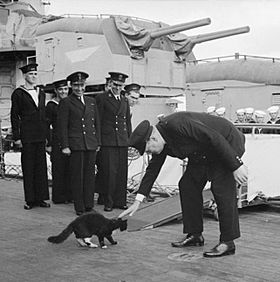
After repairs, Prince of Wales had a special mission. She carried Prime Minister Winston Churchill across the Atlantic Ocean. He was going to a secret meeting with US President Franklin D. Roosevelt. This meeting happened in August 1941 in Newfoundland.
On 9 August, Churchill arrived on Prince of Wales. Roosevelt met him on board. The meeting lasted from 10 to 12 August. At the end, they announced the Atlantic Charter. This was an important agreement about goals for the world after the war. Prince of Wales returned to Britain on 18 August.
Mediterranean Sea Duty
In September 1941, Prince of Wales went to the Mediterranean Sea. She joined a group of ships called Force H. On 24 September, she helped protect a supply convoy. This convoy was going from Gibraltar to Malta.
On 27 September, Italian planes attacked the convoy. Prince of Wales shot down several planes with her guns. Later, there were reports of Italian warships nearby. Prince of Wales and other ships went to find them, but found nothing. The convoy reached Malta safely. Prince of Wales then returned to Britain.
Final Journey to the Far East
On 25 October, Prince of Wales sailed for Singapore. She was to meet the battlecruiser Repulse. Another ship, Indomitable, ran aground and couldn't join. Prince of Wales stopped in South Africa, Mauritius, and the Maldive Islands to refuel. She reached Colombo, Ceylon, on 28 November. She joined Repulse the next day. On 2 December, the ships arrived in Singapore. Prince of Wales became the flagship for Force Z. This group was led by Admiral Sir Tom Phillips.
Japanese troop ships were seen on 6 December. Two days later, Japanese planes attacked Singapore. Prince of Wales's anti-aircraft guns fired, but hit nothing. Admiral Phillips decided to sail out to attack Japanese transports. He believed the RAF would provide air cover. Force Z included Prince of Wales, Repulse, and four destroyers.
On 9 December, a Japanese submarine spotted the British ships. Later, Japanese planes also found them. It became clear that no RAF fighter planes would be available. At midnight, a report came that Japanese forces were landing at Kota Bharu. Force Z went to investigate. But when they arrived on 10 December, it was a false alarm.
At 11:00 that morning, the first Japanese air attack began. Bombers attacked Repulse. At 11:30, torpedo planes attacked. Prince of Wales was hit by one torpedo on her left side. This damaged her propeller shaft and caused severe flooding. It also knocked out her electrical system in the back of the ship. She began to list heavily.
More torpedo attacks followed. Repulse was hit and sank at 12:33. Six planes then attacked Prince of Wales again. They hit her with three more torpedoes. A 500-kilogram (1,100 lb) bomb also hit her deck and exploded. This caused many casualties. Other bombs exploded very close, damaging her hull and increasing flooding.
At 13:15, the order was given to abandon ship. At 13:20, Prince of Wales capsized and sank. Admiral Phillips and Captain Leach were among the 327 people who died.
What Happened After?
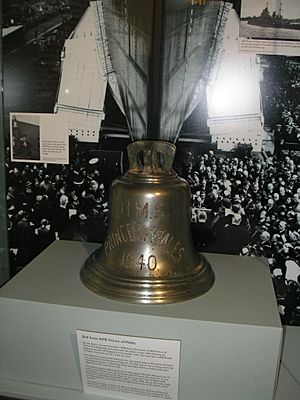
The sinking of Prince of Wales and Repulse was a big moment in naval history. They were the first large warships sunk only by planes on the open sea. This showed that air power was becoming very important. Some reasons for the sinking included her surface-scanning radars not working well in the hot climate. This meant Force Z didn't get early warnings. Also, the early damage to her dynamos caused electrical failures. This meant her pumps couldn't work well to stop the flooding.
After the war, divers explored the wreck. They found the true causes of the ship's loss. The report on the sinking said that her anti-aircraft guns could have done more damage to the planes. But the crews needed more training.
The Shipwreck Today
The wreck of Prince of Wales lies upside down in 223 feet (68 m) of water. It is a 'Protected Place' since 2001. This means it is a war grave and should not be disturbed. A Royal Navy flag is placed on a buoy above the wreck. It is replaced regularly.
The ship's bell was brought up in 2002. This was done by British divers with permission. It is now on display at the National Museum of the Royal Navy in Portsmouth.
In 2007, an expedition studied the outside of the wreck. Their findings helped naval experts understand the damage. In 2014, it was reported that scrap metal dealers were damaging the wreck with explosives. This is illegal and disrespectful.
Today, every passing Royal Navy ship performs a special service. They remember the brave sailors who died on the Prince of Wales and Repulse.
Ship Upgrades and Changes
Prince of Wales had several upgrades during her service. These were done to keep her equipment modern. Here are some of the changes made:
| Dates | Location | What Was Done |
|---|---|---|
| May 1941 | Rosyth | New radar systems (Type 282 and Type 285) were added. |
| June–July 1941 | Rosyth | UP projectors were removed. More 2-pounder "pom-pom" guns were added. A Type 271 radar was also added. |
| November 1941 | Cape Town | Seven single 20 mm anti-aircraft guns were added. |
Images for kids
See also
 In Spanish: HMS Prince of Wales (53) para niños
In Spanish: HMS Prince of Wales (53) para niños


